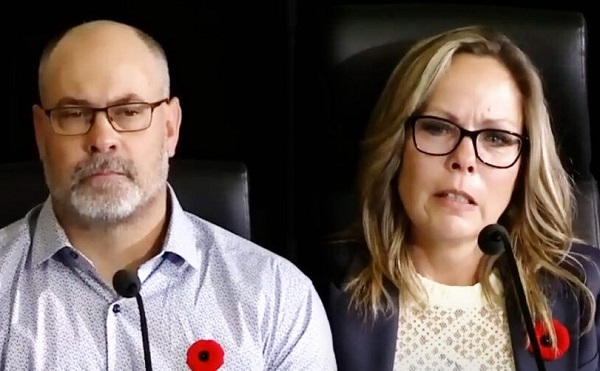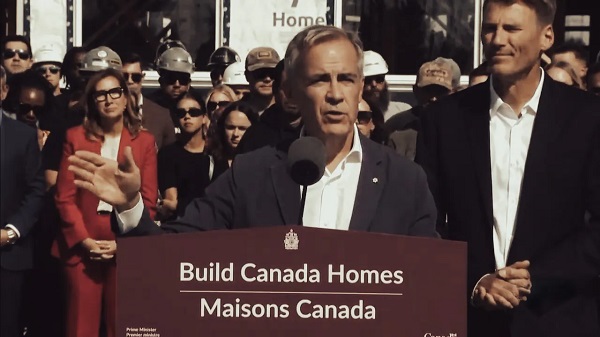Alberta
Healthcare Innovation Isn’t ‘Scary.’ Canada’s Broken System Is

From the Frontier Centre for Public Policy
“Our healthcare system is a monopoly installed at every level with the culture inherent to monopolies, whether public or private. The culture is based on regulation and budgetary controls, closed to the outside world, impermeable to real change, adaptation and innovation. It is a culture that favours inefficiency.”
Why is the Globe and Mail afraid of healthcare reform that works?
The Globe and Mail editorial board seems to find healthcare innovation “scary.”
On Sept. 3, it published an editorial called “Danielle Smith has a scary fix for healthcare,” criticizing the Alberta Premier’s idea to introduce competition in the province’s health system. Premier Smith’s plan involves third-party leasing of underperforming hospitals while the government retains ownership and continues funding.
Let’s be clear: the real problem isn’t Smith’s proposal – it’s the current state of healthcare across Alberta and Canada. Sticking with the status quo of underperformance is what should truly alarm us. Rather than attacking those trying to fix a broken system, we should focus on much-needed reforms.
So, what exactly is Smith proposing? Contrary to what you may have heard, she isn’t dismantling Alberta’s universal healthcare or introducing an American style system. Yet the public sector unions – and certain media outlets – seem to jump into hysterics any time innovation is proposed, particularly when it involves private-sector competition.
Predictably, groups like Friends of Medicare, with their union ties, are quick to raise the alarm. Yet media coverage often fails to disclose this affiliation, leaving readers with the impression that their views are impartial. Take Global News’ recent coverage, for example:
In late August, Global News reporter Jasmine King presented a story on potential changes to Alberta’s healthcare system. She featured a spokesperson from Friends of Medicare, who predicted that the changes would be detrimental to the province. However, the report failed to mention that Friends of Medicare is affiliated with public sector unions and has a history of opposing any private sector involvement in healthcare. The news segment also included a statement from the dean of a medical faculty, who was critical of the proposed changes. Missing from the report were any voices in favour of healthcare innovation.
Here’s the real issue: Canada is an outlier in its resistance to competition in healthcare. Many European countries, which also have universal healthcare systems, allow private and non-profit organizations to operate hospitals. These systems function effectively without the kind of fear-mongering that dominates the Canadian debate.
Instead of fear-based comparisons to the U.S., let’s acknowledge the success stories of countries that have embraced a mixed system of healthcare delivery. But lazy, fear-driven reporting means we keep hearing the same tired arguments against change, with little context or consideration of alternatives that are working elsewhere.
It’s ironic that The Globe and Mail editorial aims to generate fear about a health care policy proposal that could, contrary to the alarmist reaction, potentially improve efficiency and care in Alberta. The only thing we truly have to fear in healthcare is the stagnation and inefficiency of the current system.
Claude Castonguay, the architect of Quebec’s Medicare system, released a report in 2008 on that province’s health system, calling for increased competition and choice in healthcare.
“In almost every other public and private areas, monopolies are simply not accepted,” he wrote. “Our healthcare system is a monopoly installed at every level with the culture inherent to monopolies, whether public or private. The culture is based on regulation and budgetary controls, closed to the outside world, impermeable to real change, adaptation and innovation. It is a culture that favours inefficiency.”
The fear of competition is misguided, and Canadians are increasingly open to the idea of paying for private treatment when the public system falls short.
Let’s stop demonizing those who propose solutions and start addressing the real issue: a system that is no longer delivering the care Canadians need. The future of healthcare depends on embracing innovation, not clinging to outdated models and misplaced fears.
Joseph Quesnel is a Senior Research Fellow with the Frontier Centre for Public Policy.
Alberta
Tell the Province what you think about 120 km/h speed limit on divided highways

Alberta’s government is engaging with Albertans on increasing speed limits on rural highways.
Starting Nov. 7, Albertans can share their views on modernizing speed limits on divided highways through an online survey running until Dec. 12. The survey will ask how Albertans view raising the speed limit by 10 km/h on various highways from 110 km/h to 120 km/h.
“Alberta’s government is investigating how to safely increase speed limits on divided highways, and if Albertans support increasing speed limits. We are investing more than $1.5 billion this year alone to improve highway safety and upgrade infrastructure across the province. We want Albertans to be able to drive the speed limit that the highways are designed for. Modern vehicles combined with public awareness mean we can explore higher speed limits.”
The survey will provide Albertans with the opportunity to provide input on which highways they would prioritize having a speed limit increase, their views on restricting commercial trucks from using the far-left lane on highways with three or more lanes and any other feedback that would improve driving experiences on provincial highways.
Following a review of the survey results, Alberta’s government plans to conduct a mini-trial of a 120 km/h speed limit to assess the impacts of higher speed limits on divided highways. The trial will include strong monitoring to assess driving behaviour.
Alberta’s government reminds motorists to slow down and drive to the conditions. Speed limits are set for ideal conditions. When roads are wet, icy or when there is reduced visibility, motorists should slow down.
Quick facts
- Alberta’s provincial highway network includes more than 64,000 lane kilometres of highways, about 11,700 lane kilometres of which are divided.
- The posted speed limits of Alberta’s divided highways range from 100 to 110 km/h, although the posted speed limits on segments passing through cities, towns and First Nation lands can be as low as 50 km/h due to factors such as signalized intersections, pedestrians and local access.
Related information
- The survey is available online.
Alberta
Alberta Announces Members of Class Size and Complexity Committee

A new Class Size and Complexity Cabinet Committee has been struck to address classroom challenges.
Taking action on class size and complexity
Classrooms in Alberta continue to grow and are becoming increasingly complex, and immediate action is needed to address these issues in the public education system. To meet these issues head on, the Class Size and Complexity Cabinet Committee has been created. The cabinet committee will help guide government policy and deploy resources to deal with class sizes and classroom complexity.
“We are committed to providing world-class education, and we’re building schools and funding education at a rate unprecedented in this province. This committee will help us address the concerns of teachers, parents and students around class sizes and complexity.”
Throughout November, Alberta’s government will continue work with school boards to collect data on class sizes and classroom composition. The cabinet committee will use this data to direct resources to the classrooms that need it the most. Starting in January, this data will be made available and released annually.
The Class Size and Complexity Cabinet Committee will be co-chaired by the Premier of Alberta and the Minister of Education and Childcare. It will also include non-voting members representing school boards, administrators and a teacher representative of the ATA. The committee will also hear from school boards, academic experts, teachers, educational assistants, complex needs specialists and parents to inform its decisions and guide this vital work.
“We heard teacher concerns, and we are providing solutions. The Class Size and Complexity Cabinet Committee will help us take immediate action and ensure teachers and students are given the support they need to succeed.”
In June 2025, Alberta’s government established the Aggression and Complexity in Schools Action Team to provide advice on addressing classroom complexity. The report has been received and will be released soon. Over the coming months, the cabinet committee will start rolling out solutions informed by the action team’s recommendations. In addition, the committee will guide the creation of a new inclusive education policy framework.
“The work of this committee will support teachers in responding to the growing complexity in our classrooms. We will ensure that the voices of the contributors to the initial work guide
solutions that truly improve the educational experience for students and the educators who serve them.”
“I appreciate the government’s recognition of the impact of classroom complexity and their commitment to working collaboratively for improvement. Supporting teachers ultimately improves classroom conditions and student outcomes.”
Using data collected, this cabinet committee will also guide Alberta’s government in executing its commitment to hire 3,000 new teachers and 1,500 new educational assistants over the next three years. They will also assist in identifying and prioritizing where new schools and modulars should be built, advancing the government’s commitment to invest $8.6 billion to build 130 new schools, and provide 109 modular classrooms in the growing communities that need them urgently.
Quick facts
- Members of the Class Size and Complexity Cabinet Committee include:
- Danielle Smith, Premier of Alberta
- Demetrios Nicolaides, Minister of Education and Childcare
- Jason Nixon, Minister of Assisted Living and Social Services
- Rick Wilson, Minister of Mental Health and Addiction
- Searle Turton, Minister of Child and Family Services
- Lynnette Anderson, chief superintendent, Edmonton Catholic Schools
- Nicole Buchanan, chair, Red Deer Public Schools
- Marilyn Dennis, former president of Alberta School Boards Association
- Mike McMann, superintendent, Fort Vermilion Schools and President, College of Alberta School Superintendents
- Joanne Pitman, chief superintendent, Calgary Board of Education
- Dr. Elissa Corsi, Alberta Teachers’ Association
- Only Cabinet members are voting members. Additional guests will be invited to attend and share their expertise at the discretion of the chairs.
- School boards will be required to submit data on Alberta classrooms by Nov. 24.
-

 espionage2 days ago
espionage2 days agoU.S. Charges Three More Chinese Scholars in Wuhan Bio-Smuggling Case, Citing Pattern of Foreign Exploitation in American Research Labs
-

 Business1 day ago
Business1 day agoCarney budget doubles down on Trudeau-era policies
-

 COVID-191 day ago
COVID-191 day agoCrown still working to put Lich and Barber in jail
-

 Business1 day ago
Business1 day agoCarney’s Deficit Numbers Deserve Scrutiny After Trudeau’s Forecasting Failures
-

 International1 day ago
International1 day agoKazakhstan joins Abraham Accords, Trump says more nations lining up for peace
-

 Business1 day ago
Business1 day agoCarney budget continues misguided ‘Build Canada Homes’ approach
-

 armed forces16 hours ago
armed forces16 hours agoIt’s time for Canada to remember, the heroes of Kapyong
-

 Energy18 hours ago
Energy18 hours agoCanada Cannot Become an Energy Superpower With its Regulatory Impediments






